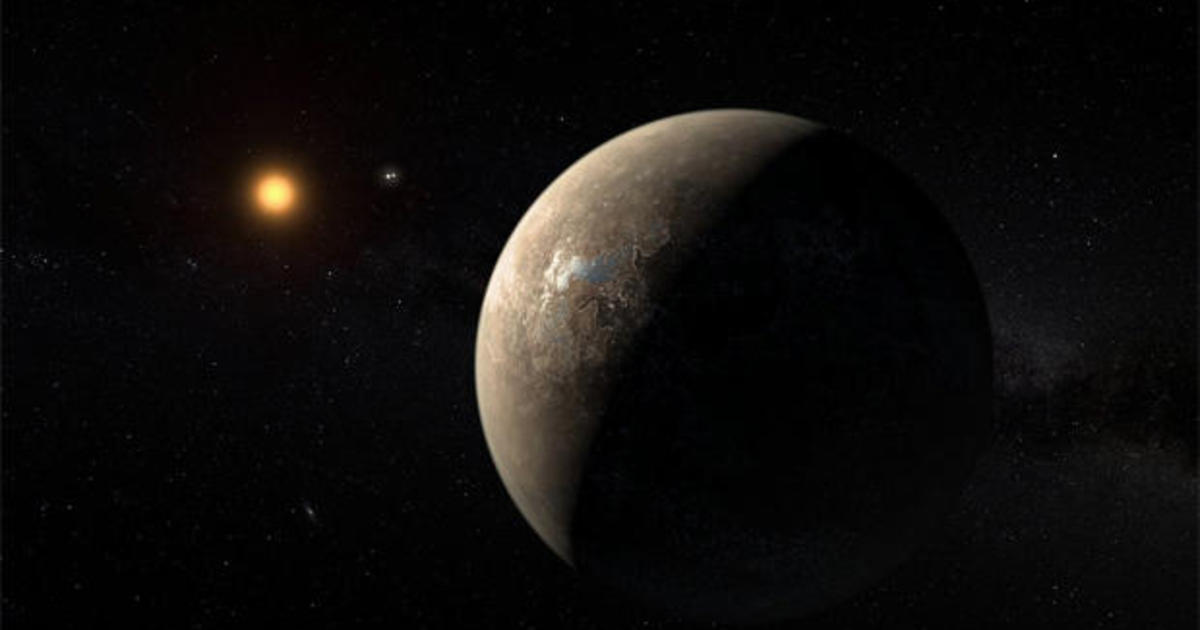August 24, 2016
Although Proxima is considered a moderately active star, its rotation period is about 83 days (ref. 3) and its quiescent activity levels and X-ray luminosity4 are comparable to those of the Sun. Here we report observations that reveal the presence of a small planet with a minimum mass of about 1.3 Earth masses orbiting Proxima with a period of approximately 11.2 days at a semi-major-axis distance of around 0.05 astronomical units. Its equilibrium temperature is within the range where water could be liquid on its surface5.


Posted by: The Brickmuppet at
03:08 PM
| Comments (3)
| Add Comment
Post contains 559 words, total size 8 kb.
It is by no means certain that Proxima is part of the Alpha Centauri system, by which I mean in orbit around the two main stars. It's possible Proxima is making a one-time hyperbolic pass.
Which wouldn't matter for our purposes; either way it will be thousands of years before it has moved very far away from where it is now. And if it is in orbit the orbital period is probably measured in tens of thousands of years.
Posted by: Steven Den Beste at Wed Aug 24 18:08:26 2016 (+rSRq)
The big question I would have about any planet which is that close to its star (even if the star is a midget like Proxima) is whether the planet is tide-locked. If so, with the same face always toward the star, then you can forget about life.
And you can forget about terraforming.
An artificial colony might still be possible, built at one of the dawn/dusk lines, but it would have to be entirely enclosed.
A different possibility is that it's like Mercury and caught in a 3:2 resonance. Which means each planetary day is 1.5 planetary years long. In that case each day would be 8 Earth days long and each night likewise. I think you can still forget about life; the daily temperature swings would be brutal.
And the only places you might be able to build artificial colonies would be the poles.
Sorry; I'm no fun.
Posted by: Steven Den Beste at Thu Aug 25 20:02:38 2016 (+rSRq)
There is also the possibility that the atmosphere might provide convectional temperature stabilization and preventing the atmosphere and oceans from freezing out. Interestingly, a study on this recently found that 2/3rds of simulations had this result and due to something to do with coriolis effects, this happy result was quite likely if the day/year was less than 12 Earth days. Proxima Centauri b has a 11 day long year.
As you mention, it could be in resonance Mercury in which case it has long days and nights. Given that this planet's year is about 11 earth days long, 3:2 resonance would mean nights lasting 14-15 earth days which isn't a deal breaker. Dense, biologically rich forests in Alaska have that much darkness or more.
A bigger concern, would be magnetic fields, though even regarding that, Ganymede, which is an icy moon, far less dense than Earth, and tidally locked to something far less massive has a powerful magnetic field. A much more massive terrestrial planet with a big iron core would have a far more powerful one which might protect it from having the atmosphere stripped off.
Finally, a tidally locked world still has a slight wobble (libration), allowing for a "day/night" cycle around the twilight band.
Posted by: The Brickmuppet at Thu Aug 25 23:18:42 2016 (1zM3A)
71 queries taking 0.0904 seconds, 276 records returned.
Powered by Minx 1.1.6c-pink.









